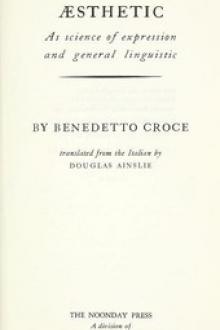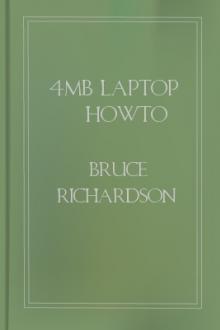Aesthetic as Science of Expression and General Linguistic, Benedetto Croce [read e books online free TXT] 📗

- Author: Benedetto Croce
- Performer: 1426434839
Book online «Aesthetic as Science of Expression and General Linguistic, Benedetto Croce [read e books online free TXT] 📗». Author Benedetto Croce
Kant is shut in with intellectualist barriers. A complete definition of the imagination is wanting to his system. He does not admit that the imagination belongs to the powers of the mind. He relegates it to the facts of sensation. He is aware of the reproductive and combinative imagination, but he does not recognize fancy (_fantasia_), which is the true productive imagination.
Yet Kant was aware that there exists an activity other than the intellective. Intuition is referred to by him as preceding intellective activity and differing from sensation. He does not speak of it, however, in his critique of art, but in the first section of the Critique of Pure Reason. Sensations do not enter the mind, until it has given them form. This is neither sensation nor intelligence. It is pure intuition, the sum of the a priori principles of sensibility. He speaks thus: “There must, then, exist a science that forms the first part of the transcendental doctrine of the elements, distinct from that which contains the principles of pure thought and is called transcendental Logic.”
What does he call this new science? He calls it Transcendental Aesthetic, and refuses to allow the term to be used for the Critique of Taste, which could never become a science.
But although he thus states so clearly the necessity of a science of the form of the sensations, that is of pure intuition, Kant here appears to fall into grave error. This arises from his inexact idea of the essence of the aesthetic faculty or of art, which, as we now know, is pure intuition. He conceives the form of sensibility to be reducible to the two categories of space and time.
Benedetto Croce has shown that space and time are far from being categories or functions: they are complex posterior formations. Kant, however, looked upon density, colour, etc., as material for sensations; but the mind only observes colour or hardness when it has already
given a form to its sensations. Sensations, in so far as they are crude matter, are outside the mind: they are a limit. Colour, hardness, density, etc., are already intuitions. They are the aesthetic activity in its rudimentary manifestation.
Characterizing or qualifying imagination, that is, aesthetic activity, should therefore take the place occupied by the study of space and time in the Critique of Pure Reason, and constitute the true Transcendental Aesthetic, prologue to Logic.
Had Kant done this, he would have surpassed Leibnitz and Baumgarten; he would have equalled Vico.
Kant did not identify the Beautiful with art. He established what he called “the four moments of Beauty,” amounting to a definition of it.
The two negative moments are, “That is beautiful which pleases without interest“; this thesis was directed against the sensualist school of English writers, with whom Kant had for a time agreed; and “That is beautiful which pleases without a concept,” directed against the intellectualists. Thus he affirmed the existence of a spiritual domain, distinct from that of organic pleasure, of the useful, the good, and the true. The two other moments are, “That is beautiful which has the form of finality without the representation of an end,” and “That is beautiful which is the object of universal pleasure.” What is this disinterested pleasure that we experience before pure colours, pure sounds, and flowers? Benedetto Croce replies that this mysterious domain has no existence; that the instances cited represent, either instances of organic pleasure, or are artistic facts of expression.
Kant was less severe with the Neoplatonicians than with the two schools of thought above mentioned. His Critique of Judgment contains some curious passages, in one of which he gives his distinction of form from matter: “In music, the melody is the matter, harmony the form: in a flower, the scent is the matter, the shape or configuration the form.”
In the other arts, he found that the design was the essential. “Not what pleases in sensation, but what is approved for its form, is the foundation of taste.”
In his pursuit of the phantom of a beauty, which is neither that of art nor of sensual pleasure, exempt alike from expression and from enjoyment, he became enveloped in inextricable contradictions. Little disposed as he was to let himself be carried away by the imagination, he expressed his contempt for philosopher-poets like Herder, and kept saying and unsaying, affirming and then immediately criticizing his own affirmations as to this mysterious beauty. The truth is that this mystery is simply his own individual uncertainty before a problem which he could not solve, owing to his having no clear idea of an activity of sentiment. Such an activity represented for him a logical contradiction.
Such expressions as “necessary universal pleasure,” “finality without the idea of end,” are verbal proofs of his uncertainty.
How was he to emerge from this uncertainty, this contradiction? He fell back upon the concept of a base of subjective finality as the base of the judgment of taste, that is of the subjective finality of nature by the judgment. But nothing can be known or disclosed to the object by means of this concept, which is indeterminate in itself and not adapted for knowledge. Its determining reason is perhaps situated in “the suprasensible substratum of humanity.” Thus beauty becomes a symbol of morality. “The subjective principle alone, that is, the indeterminate idea of the suprasensible in us, can be indicated as the sole key to reveal this faculty, which remains unknown to us in its origin. Nothing but this principle can make that hidden faculty comprehensible.”
Kant had a tendency to mysticism, which this statement does not serve to conceal, but it was a mysticism without enthusiasm, a mysticism almost against the grain. His failure to penetrate thoroughly the nature of the aesthetic activity led him to see double and even triple, on several occasions. Art being unknown to him in its essential nature, he invents the functions of space and time and terms this transcendental aesthetic; he develops the theory of the imaginative beautifying of the intellectual concept by genius; he is finally forced to admit a mysterious power of feeling, intermediate between the theoretic and the practical activity. This power is cognoscitive and non-cognoscitive, moral and indifferent to morality, agreeable and yet detached from the pleasure of the senses. His successors hastened to make use of this mysterious power, for they were glad to be able to find some sort of justification for their bold speculations in the severe philosopher of K�nigsberg.
In addition to Schelling and Hegel, for whom, as has been said, the Critique of Judgment seemed the most important of the three Critiques, we must now mention the name of a poet who showed himself as great in philosophical as in aesthetic achievement.
Friedrich Schiller first elaborated that portion of the Kantian thought contained in the Critique of Judgment. Before any professional philosopher, Schiller studied that sphere of activity which unites feeling with reason. Hegel talks with admiration of this artistic genius, who was also so profoundly philosophical and first announced the principle of reconciliation between life as duty and reason on the one hand, and the life of the senses and feeling on the other.
To Schiller belongs the great merit of having opposed the subjective idealism of Kant and of having made the attempt to surpass it.
The exact relations between Kant and Schiller, and the extent to which the latter may have been influenced by Leibnitz and Herder, are of less importance to the history of Aesthetic than the fact that Schiller unified once for all art and beauty, which had been separated by Kant, with his distinctions between adherent and pure beauty. Schiller’s artistic sense must doubtless have stood him here in good stead.
Schiller found a very unfortunate and misleading term to apply to the aesthetic sphere. He called it the sphere of play (Spiel). He strove to explain that by this he did not mean ordinary games, nor material amusement. For Schiller, this sphere of play lay intermediate between thought and feeling. Necessity in art gives place to a free disposition of forces; mind and nature, matter and form are here reconciled. The beautiful is life, but not physiological life. A beautiful statue may have life, and a living man be without it. Art conquers nature with form. The great artist effaces matter with form. The less we are sensible of the material in a work of art, the greater the triumph of the artist. The soul of the spectator should leave the magic sphere of art as pure and as perfect as when it left the hands of the Creator. The most frivolous theme should be so treated that we can pass at once from it to the most rigorous, and vice versa. Only when man has placed himself outside the world and contemplates it aesthetically, can he know the world. While he is merely the passive receiver of sensations, he is one with the world, and therefore cannot realize it. Art is indeterminism. With the help of art, man delivers himself from the yoke of the senses, and is at the same time free of any rational or moral duty: he may enjoy for a moment the luxury of serene contemplation.
Schiller was well aware that the moment art is employed to teach morals directly, it ceases to be art. All other teachings give to the soul a special imprint. Art alone is favourable to all without prejudice. Owing to this indifference of art, it possesses a great educative power, by opening the path to morality without preaching or persuasion; without determining, it produces determinability. This was the main theme of the celebrated “Letters on the Aesthetic Education of Man,” which Schiller wrote to his patron the Duke of Holstein-Augustenburg. Here, and in his lectures at the University of Jena, it is clear that Schiller addresses himself to a popular audience. He began a work, on scientific Aesthetic, which he intended to entitle “Kallias,” but unfortunately died without completing it. We possess only a few fragments, contained in his correspondence with his friend K�rner. K�rner did not feel satisfied with the formula of Schiller, and asks for some more precise and objective mark of the beautiful. Schiller tells him that he has found it, but what he had found we shall never know, as there is no document to inform us.
The fault of Schiller’s aesthetic theory was its lack of precision. His artistic faculty enabled him to give unsurpassable descriptions of the catharsis and of other effects of art, but he fails to give a precise definition of the aesthetic function. True, he disassociates it from morality, yet admits that it may in a measure be associated with it. The only formal activities that he recognizes are the moral and the intellectual, and he denies altogether (against the sensualists) that art can have anything to do with passion or sensuality. His intellectual world consisted only of the logical and the intellectual, leaving out the imaginative activity.
What is art for Schiller? He admits four modes of relation between man and external things. They are the physical, the logical, the moral, and the aesthetic. He describes this latter as a mode by which things affect the whole of our different forces, without being a definite object for any one in particular. Thus a





Comments (0)